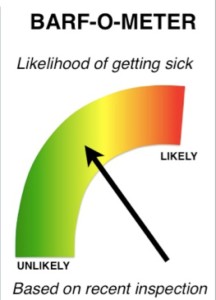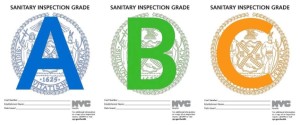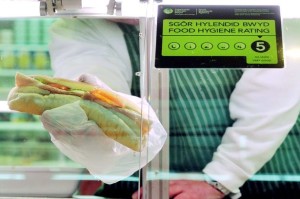Customers will soon be able to view a food safety grade on the entrance of Dubai food outlets as part of an upcoming “Name and Fame” scheme, an official said on Sunday.
 The scheme will reveal whether the outlet has passed, failed or obtained a conditional pass in official food safety inspections.
The scheme will reveal whether the outlet has passed, failed or obtained a conditional pass in official food safety inspections.
It will also assign what will probably be a letter grade indicating the level of compliance, with “A” being the highest and “E” the lowest.
The scheme was announced during the ninth Dubai International Food Safety Conference, which lasts until Tuesday.
“We want to let consumers know who’s doing well. It’ll invite people to make food safety their priority,” Sultan Al Tahir, head of inspections at Dubai Municipality’s food control department, said.
“The grade will be posted outside the place. We’ll implement this in the future.”
Al Tahir said more than 200 out of 13,000 food establishments in Dubai are of A-grade standing. Those falling in the E category are 430.
It is understood the grades will be revised if necessary after scheduled and spot food safety inspection results.
Also planned for consumers is a smart barcode system which will let smartphone users scan the product information on the packaging of all food products in the UAE, said Khalid Mohammad Sharif, the municipality department’s executive director.
 Using an app in their smart device, customers will be able to scan a code that will reveal a catalogue of information, such as nutrition facts, expiry date, ingredients, and country of origin.
Using an app in their smart device, customers will be able to scan a code that will reveal a catalogue of information, such as nutrition facts, expiry date, ingredients, and country of origin.
The code will also reveal if the product has ever been flagged by authorities.
“Consumers will know if it has had any previous history. It means more control and transparency, which is good for everybody. All of that will be on your smartphone,” Sharif added.
The system will also reveal if the product is registered with federal authorities, which will become mandatory some time in 2015, he said.
The Dubai Municipality plans to shut down food outlets that do not raise their food safety standards to the highest level before the emirate hosts the World Expo in 2020, a senior official revealed on Sunday.
“We want all food outlets in Dubai to be in ‘A’ and ‘B’ categories. We don’t want any restaurant or hotel below those grades by 2020,” Khalid Mohammed Sherif Al Awadhi said.
Speaking to Khaleej Times on the sidelines of the 9th Dubai International Food Safety Conference (DIFSC) on Sunday, Al Awadhi said it is high time that eateries raised their standards to make Dubai the best place to dine in.












